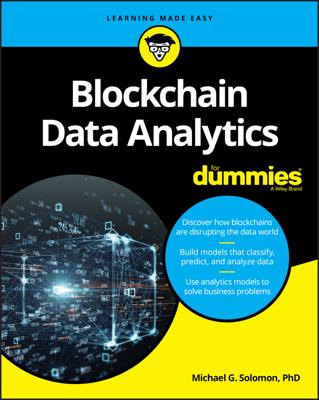The good news is that you aren’t the pioneer in blockchain analytics. Other organizations of all sizes have seen the value of formal analysis of blockchain data. Examining what other organizations have done can be encouraging and insightful. You’ll probably find some fresh ideas as you familiarize yourself with what others have accomplished with their blockchain analytics projects.
Here, you learn about ten ways in which blockchain analytics can be useful to today’s (and tomorrow’s) organizations. Blockchain analytics focuses on analyzing what happened in the past, explaining what's happening now, and even preparing for what's expected to come in the future. Analytics can help any organization react, understand, prepare, and lower overall risk.
Accessing public financial transaction data
The first blockchain implementation, Bitcoin, is all about cryptocurrency, so it stands to reason that examining financial transactions would be an obvious use of blockchain analytics. If tracking transactions was your first thought of how to use blockchain analytics, you’d be right. Bitcoin and other blockchain cryptocurrencies used to be viewed as completely anonymous methods of executing financial transactions.The flawed perception of complete anonymity enticed criminals to use the new type of currency to conduct illegal business. Since cryptocurrency accounts aren’t directly associated with real-world identities (at least on the blockchain), any users who wanted to conduct secret business warmed up to Bitcoin and other cryptocurrencies.
When law enforcement noticed the growth in cryptocurrency transactions, they began looking for ways to re-identify transactions of interest. It turns out that with a little effort and proper legal authority, it isn’t that hard to figure out who owns a cryptocurrency account. When a cryptocurrency account is converted and transferred to a traditional account, many criminals are unmasked. Law enforcement became an early adopter of blockchain analytics and still uses models today to help identify suspected criminal and fraudulent activity.
Chainalysis is a company that specializes in cryptocurrency investigations. Their product, Chainalysis Reactor, allows users to conduct cryptocurrency forensics to connect transactions to real-world identities. The image shows the Chainalysis Reactor tool.
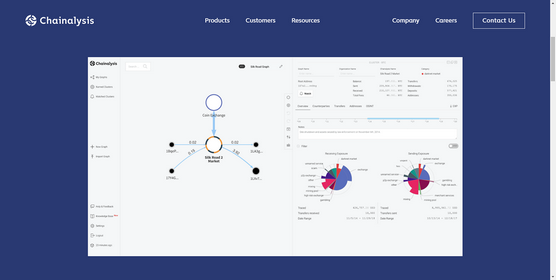 Chainalysis Reactor
Chainalysis ReactorBut blockchain technology isn’t just for criminals, and blockchain analytics isn’t just to catch bad guys. The growing popularity of blockchain and cryptocurrencies could lead to new ways to evaluate entire industries, P2P transactions, currency flow, the wealth of nation-states, and a variety of other market valuations with this new area of analysis. For example, Ethereum has emerged as a major avenue of fundraising for tech startups, and its analysis could lend a deeper look into the industry.
Connecting with the Internet of Things (IoT)
The Internet of Things (IoT) is loosely defined as the collection of devices of all sizes that are connected to the internet and operate at some level with little human interaction. IoT devices include doorbell cameras, remote temperature sensors, undersea oil leak detectors, refrigerators, and vehicle components. The list is almost endless, as is the number of devices connecting to the internet.Each IoT device has a unique identity and produces and consumes data. All of these devices need some entity that manages data exchange and the device’s operation. Although most IoT devices are autonomous (they operate without the need for external guidance), all devices eventually need to request or send data to someone. But that someone doesn’t have to be a human.
Currently, the centralized nature of traditional IoT systems reduces their scalability and can create bottlenecks. A central management entity can handle only a limited number of devices. Many companies working in the IoT space are looking to leverage the smart contracts in blockchain networks to allow IoT devices to work more securely and autonomously. These smart contracts are becoming increasingly attractive as the number of IoT devices exceeds 20 billion worldwide in 2020.
The figure below shows how IoT has matured from a purely centralized network in the past to a distributed network (which still had some central hubs) to a vision of the future without the need for central managers.
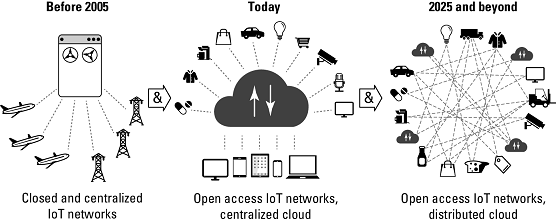 Moving toward distributed, autonomous IoT
Moving toward distributed, autonomous IoTThe applications of IoT data are endless, and if the industry does shift in this direction, knowing and understanding blockchain analytics will be necessary to truly unlock its potential. Using blockchain technology to manage IoT devices is only the beginning. Without the application of analytics to really understand the huge volume of data IoT devices will be generating, much of the value of having so many autonomous devices will be lost.
Ensuring data and document authenticity
The Lenovo Group is a multinational technology company that manufactures and distributes consumer electronics. During a business process review, Lenovo identified several areas of inefficiency in their supply chain. After analyzing the issues, they decided to incorporate blockchain technology to increase visibility, consistency, and autonomy, and to decrease waste and process delays. Lenovo published a paper, “Blockchain Technology for Business: A Lenovo Point of View,” detailing their efforts and results.In addition to describing their supply chain application of blockchain technology in their paper, Lenovo cited examples of how the New York Times uses blockchain to prove that photos are authentic. They also described how the city of Dubai is working to have all its government documents on blockchain by the end of 2020 in an effort to crack down on corruption and the misuse of funds.
In the era of deep fakes, manipulated photos and consistently evolving methods of corruption and misappropriation of funds, blockchain can help identify cases of data fraud and misuse. Blockchain’s inherent transparency and immutability means that data cannot be retroactively manipulated to support a narrative. Facts in a blockchain are recorded as unchangeable facts. Analytics models can help researchers understand how data of any type originated, who the original owner was, how it gets amended over time, and if any amendments are coordinated.
Controlling secure document integrity
As just mentioned, blockchain technology can be used to ensure document authenticity, but it can be used also to ensure document integrity. In areas where documents should not be able to be altered, such as the legal and healthcare industries, blockchain can help make documents and changes to them transparent and immutable, as well as increase the power the owner of the data has to control and manage it.Documents do not have to be stored in the blockchain to benefit from the technology. Documents can be stored in off-chain repositories, with a hash stored in a block on the blockchain. Each transaction (required to write to a new block) contains the owner’s account and a timestamp of the action. The integrity of any document at a specific point in time can be validated simply by comparing the on-chain hash with the calculated hash value of the document. If the hash values match, the document has not changed since the blockchain transaction was created.
The company DocStamp has implemented a novel use for blockchain document management. Using DocStamp, shown below, anyone can self-notarize any document. The document owner maintains control of the document while storing a hash of the document on an Ethereum blockchain.
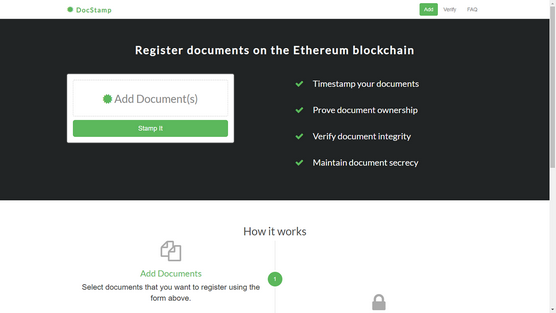 The DocStamp website
The DocStamp websiteServices such as DocStamp provide the capability to ensure document integrity using blockchain technology. However, assessing document integrity and its use is up to analytics models. The DocStamp model is not generally recognized by courts of law to be as strong as a traditional notary. For that to change, analysts will need to provide model results that show how the approach works and how blockchain can help provide evidence that document integrity is ensured.
Tracking supply chain items
In the Lenovo blockchain paper, the author described how Lenovo replaced printed paperwork in its supply chain with processes managed through smart contracts. The switch to blockchain-based process management greatly decreased the potential for human error and removed many human-related process delays. Replacing human interaction with electronic transaction increased auditability and gave all parties more transparency in the movement of goods. The Lenovo supply chain became more efficient and easier to investigate.Blockchain-based supply chain solutions are one of the most popular ways to implement blockchain technology. Blockchain technology makes it easy to track items along the supply chain, both forward and backward. The capability to track an item makes it easy to determine where an item is and where that item has been. Tracing an item’s provenance, or origin, makes root cause analysis possible. Because the blockchain keeps all history of movement through the supply chain, many types of analysis are easier than traditional data stores which can overwrite data.
The US Food and Drug Administration is working with several private firms to evaluate using blockchain technology supply chain applications to identify, track, and trace prescription drugs. Analysis of the blockchain data can provide evidence for identifying counterfeit drugs and delivery paths criminals use to get those drugs to market.
Empowering predictive analytics
You can build several models that allow you to predict future behavior based on past observations. Predictive analytics is often one of the goals of an organization’s analytics projects. Large organizations may already have a collection of data that supports prediction. Smaller organizations, however, probably lack enough data to make accurate predictions. Even large organizations would still benefit from datasets that extend beyond their own customers and partners.In the past, a common approach to acquiring enough data for meaningful analysis was to purchase data from an aggregator. Each data acquisition request costs money, and the data you receive may still be limited in scope. The prospect of using public blockchains has the potential to change the way we all access public data. If a majority of supply chain interactions, for example, use a public blockchain, that data is available to anyone — for free.
As more organizations incorporate blockchains into their operations, analysts could leverage the additional data to empower more companies to use predictive analytics with less reliance on localized data.
Analyzing real-time data
Blockchain transactions happen in real time, across intranational and international borders. Not only are banks and innovators in financial technology pursuing blockchain for the speed it offers to transactions, but data scientists and analysts are observing blockchain data changes and additions in real time, greatly increasing the potential for fast decision-making.To view how dynamic blockchain data really is, visit the Ethviewer Ethereum blockchain monitor’s website. The following image shows the Ethviewer website.
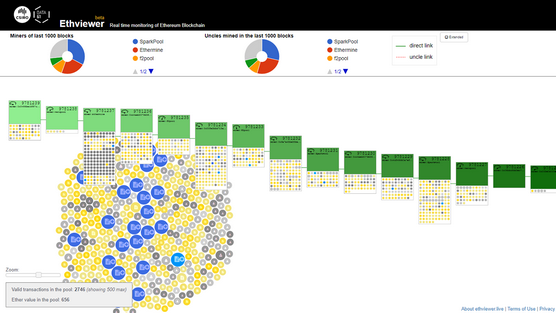 Ethviewer Ethereum blockchain monitor
Ethviewer Ethereum blockchain monitorEach small circle in the blob near the lower-left corner of the web page is a distinct transaction waiting to make it into a new block. You can see how dynamic the Ethereum blockchain is — it changes constantly. And when the blockchain changes, so does the blockchain data that your models use to provide accurate results.
Supercharging business strategy
Companies big and small — marketing firms, financial technology giants, small local retailers, and many more — can fine-tune their strategies to keep up with, and even get ahead of, shifts in the market, the economy, and their customer base. How? By utilizing the results of analytics models built on the organization’s blockchain data.The ultimate goal for any analytics project is to provide ROI for the sponsoring organization. Blockchain analytics projects provide a unique opportunity to provide value. New blockchain implementations are only recently becoming common in organizations, and now is the time to view those sources of data as new opportunities to provide value. Analytics can help identify potential sources of ROI.
Managing data sharing
Blockchain technology is often referred to as a disruptive technology, and there is some truth to that characterization. Blockchain does disrupt many things. In the context of data analytics, blockchain changes the way analysts acquire at least some of their data.If a public or consortium blockchain is the source for an analytics model, it's a near certainty that the sponsoring organization does not own all the data. Much of the data in a non-private blockchain comes from other entities that decided to place the data in a shared repository, the blockchain.
Blockchain can aid in the storage of data in a distributed network and make that data easily accessible to project teams. Easy access to data makes the whole analytics process easier. There still may be a lot of work to do, but you can always count on the facts that blockchain data is accessible and it hasn’t changed since it was written. Blockchain makes collaboration among data analysts and other data consumers easier than with more traditional data repositories.
Standardizing collaboration forms
Blockchain technology empowers analytics in more ways than just providing access to more data. Regardless of whether blockchain technology is deployed in the healthcare, legal, government, or other organizational domain, blockchain can lead to more efficient process automation.Also, blockchain’s revolutionary approach to how data is generated and shared among parties can lead to better and greater standardization in how end users populate forms and how other data gets collected. Blockchains can help encourage adherence to agreed-upon standards for data handling.
The use of data-handling standards will greatly decrease the amount of time necessary for data cleaning and management. Because cleansing data commonly requires a large time investment in the analytics process, standardization through the use of blockchain can make it easier to build and modify models with a short time-to-market.

